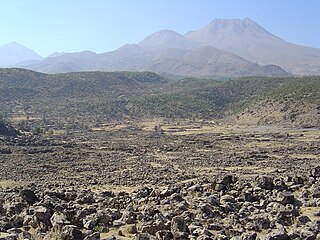Related Research Articles
Ipsus or Ipsos or Ipsous (Ἴψους), was a town of ancient Phrygia a few miles below Synnada. The place itself never was of any particular note, but it is celebrated in history for the great battle fought in its plains, in 301 BCE, by the aged Antigonus and his son Demetrius against the combined forces of Cassander, Lysimachus, and Seleucus, in which Antigonus lost his conquests and his life. From Hierocles and the Acts of Councils, we learn that in the seventh and eighth centuries it was the see of a Christian bishop. No longer the seat of a residential bishop, Ipsus remains a titular see of the Roman Catholic Church.
Patara was a small ancient city in ancient Cappadocia or Lesser Armenia,, later in Pontus. The city lay on the major trade road from Trapezus on the Black Sea to Satala, and thence to Lake Van.

Mokissos or Mokisos or Mokison (Μωκισόν) was a town of ancient Cappadocia. The Romans called the city Mocisus or Mocissus, and Mocisum, and after the city was rebuilt by the Byzantine Emperor Justinian (527-565), it was renamed Justinianopolis (Ἰουστινιανούπολις). Justinian made Mocisus the capital of the province of Cappadocia Tertia, and elevated its bishopric to the rank of ecclesiastical metropolis, with an eparchia that stretched south of the Halys River, the longest river of Asia Minor. The name Justinianopolis was retained until the end of Byzantine rule. Stephanus of Byzantium calls the town Moukissos (Μούκισσος). In the Synecdemus, the name appears as Rhegemoukisos (Ῥεγεμουκισός) and Rhegekoukisos (Ῥεγεκουκισός), the later evidently an error.
Doara was a town of ancient Cappadocia, inhabited in Byzantine times. It was in the Chamanene prefecture created by Archelaus of Cappadocia during Hellenistic times. The town appears on the Peutinger Table between Caesarea and Tavium. It was also mentioned by Hierocles as Rhegedoara (Ῥεγεδοάρα), and the Notitiae Episcopatuum.
Maionia or Maeonia, was a city of the Hellenistic, Roman and Byzantine era located near the Hermos River, in ancient Lydia. Both Ramsay and Talbert tentatively identified the ancient polis with the modern village of Koula a village known for its carpet manufacture.
Pisye or Pitye (Πίτυη) was a town of ancient Caria.
Pericharaxis was an inland town of ancient Mysia. Its name does not occur in ancient authors but is attested by epigraphic evidence.
Myloukome was a town of ancient Lydia, inhabited during Roman times.
Taza was a town of ancient Lydia, inhabited during Roman times. Its name does not occur among ancient authors, but is inferred from epigraphic and other evidence.
Iaza was a town of ancient Lydia, inhabited during Roman times. Its name does not occur among ancient authors, but is inferred from epigraphic and other evidence.
Odon was a town of ancient Lydia, inhabited during Hellenistic and Roman times. Its name does not occur among ancient authors, but is inferred from epigraphic and other evidence.
Korakoe was a town of ancient Lydia, inhabited during Roman times. Its name does not occur among ancient authors, but is inferred from epigraphic and other evidence.
Ioudda was a town of ancient Lydia, inhabited during Roman times. Its name does not occur among ancient authors, but is inferred from epigraphic and other evidence.
Doroukome was a town of ancient Lydia, inhabited during Roman times.
Koresa was a town of ancient Lydia, inhabited during Roman times.
Emoddi, also possibly called Pereudos, was a town of ancient Lydia, inhabited during Hellenistic and Roman times.
Kouara was a town of ancient Lydia, inhabited during Roman times.
Thymbrara was a town of ancient Lydia, near Sardis, not far from the small river Pactolus. The contingents of the Persian army furnished by the inhabitants of Asia Minor used to assemble at Thymbara. It may be the same place as Thybarna cited by Diodorus Siculus.
Meloukome was a town of ancient Lydia, inhabited during Roman times.
Tomara was a town of ancient Lydia, inhabited during Roman times. Its name does not occur among ancient authors, but is inferred from epigraphic and other evidence.
References
- 1 2 3 Richard Talbert, ed. (2000). Barrington Atlas of the Greek and Roman World . Princeton University Press. p. 62, and directory notes accompanying.
- ↑ Lund University. Digital Atlas of the Roman Empire.
Coordinates: 38°32′50″N28°36′11″E / 38.54711°N 28.603039°E